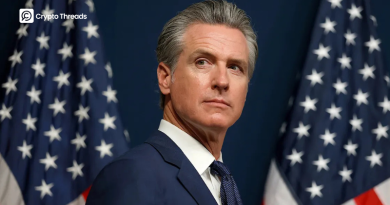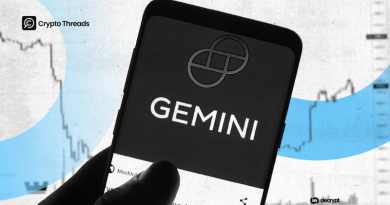Institutional Adoption Reshapes Crypto in 2025
In 2025, crypto has crossed an important threshold. Once seen mainly as a playground for retail traders and speculative bets, it is now entering a phase where institutional players set the pace. Bitcoin ETFs trade alongside blue-chip equities. Global asset managers are treating tokenized assets as part of long-term strategy rather than short-term experiments. Pension funds, sovereign wealth funds, and banks are quietly building exposure in ways that would have been unthinkable just a few years ago.
This shift is what the industry calls institutional adoption. It marks the moment when crypto ceases to be an alternative on the margins and begins to operate as a legitimate asset class within the global financial system. Unlike the retail waves that rise and collapse with sentiment, institutional participation is deliberate, long-term, and backed by trillions in managed capital.
To understand why 2025 stands out, we need to look at what institutional adoption means in practice, the data that shows its acceleration, and the broader market conditions that made this transition possible. Only then does it become clear why firms like BlackRock and Fidelity matter so much, and why their moves carry weight far beyond the crypto market itself.
What Is Institutional Adoption?
Institutional adoption refers to the stage where major financial organizations, such as asset managers, banks, insurers, pension funds, endowments, and corporate treasuries, engage directly with cryptocurrency and blockchain-based assets. This involvement is not limited to deploying capital; it also means embedding digital assets into systems of regulation, compliance, and operational infrastructure that institutions already rely on.
In the early years, crypto markets were largely the playground of technologists and speculative traders. By 2025, the situation will be very different. Institutional adoption signals that digital assets have become an investable, scalable, and professionally managed component of mainstream portfolios. Institutions do more than simply buy tokens. They introduce regulated investment products like exchange-traded funds, they build custody and auditing structures that meet the same standards as traditional finance, they open up client-facing distribution channels that make crypto accessible on a global scale, and they establish governance frameworks that allow projects to grow in a sustainable and compliant way.
The result is a fundamental shift in perception. Crypto is no longer viewed only as volatile and speculative. Through institutional adoption, it is gaining the hallmarks of an established asset class: accessible, regulated, and supported by the same systems that have long underpinned traditional markets. By 2025, institutional adoption signals that digital assets have become an investable, scalable, and risk-managed asset class for mainstream portfolios. And when institutions step in, here are what they bring:
- Regulated investment products such as ETFs and structured funds.
- Custody and auditing frameworks that meet institutional standards.
- Distribution networks that make crypto products accessible to clients worldwide.
- Governance and compliance systems designed to support long-term growth.
Institutional Adoption in 2025: Market Growth and Infrastructure Shifts
To grasp the scale of institutional adoption, it helps to look at how the market in 2025 differs from its earlier retail-driven roots. What began as a space dominated by speculative traders is now defined by the entry of asset managers, pension funds, and global banks. This transition represents more than new inflows of capital. It marks the reclassification of crypto into a legitimate, regulated, and investable asset class within mainstream finance.
Market Size and Flow Data
By mid-2025, the U.S. market for spot Bitcoin ETFs had become one of the most important channels for institutional participation in crypto. Led by products such as IBIT and FBTC, and dominated by BlackRock and Fidelity, these ETFs collectively managed between $110 and $120 billion in assets under management. The inflows were not just symbolic; on peak trading days, net inflows reached as high as $400–500 million, showing that capital was now entering Bitcoin through highly regulated investment vehicles.
The scale of potential adoption is even more striking when viewed against the broader backdrop of institutional portfolios. If global institutions were to allocate even 2% of their total assets to crypto, that would translate into $3–4 trillion of capital moving into digital assets. Compared with today’s allocation levels, this represents a structural shift in demand rather than short-term speculation.
A CoinLaw survey conducted in early 2025 underscored this momentum, finding that 71% of institutional investors had either already integrated crypto into their strategies or planned to do so within the next two years. Together, these data points reveal that institutional interest is no longer hypothetical, it is both substantial and accelerating.
Regulatory and Infrastructure Enablers
Institutional adoption in 2025 has been made possible by a convergence of regulatory reform and infrastructure maturity. The introduction of spot Bitcoin ETFs in early 2024, followed by Ether ETFs later that year, gave institutions their first regulated, liquid entry points into digital assets. These approvals removed one of the sector’s largest barriers: the absence of a standardized, compliant vehicle for large-scale investment.
A second turning point came in January 2025, when the SEC withdrew SAB 121, a rule that had imposed heavy capital penalties on banks holding crypto. Its replacement, SAB 122, offered a more pragmatic framework and cleared the path for banks to expand custody services and other crypto-related operations. This regulatory adjustment signaled that digital assets were no longer seen as an exception to traditional finance but were being brought under comparable rules.
At the same time, the operational environment reached a new level of readiness. Crypto instruments were integrated into mainstream clearing and settlement systems, allowing trading desks to handle them alongside equities, bonds, and currencies with the same efficiency. This compatibility bridged the gap between crypto markets and existing financial infrastructure, making it far easier for institutions to scale participation.
Supporting layers of infrastructure also advanced. Custodial services became more secure, staking operations were standardized, compliance and reporting tools grew more sophisticated, and interoperability protocols moved out of experimental phases into production-grade systems. Collectively, these developments reduced operational risks and provided the reliability institutions require before committing significant capital.
| Dimension | Before 2024 (Pre-ETF Era) | By 2025 (Post-ETF Integration) |
| Access to products | Limited to futures ETFs, trusts, and unregulated exchanges | Spot Bitcoin and Ether ETFs approved; regulated channels |
| Bank accounting rules | SAB 121 discouraged banks from holding crypto | SAB 122 allowed favorable treatment, enabling custody |
| Clearing & settlement | Isolated systems, crypto siloed from equity/bond desks | Integrated into clearinghouses with cross-asset workflows |
| Custody infrastructure | Fragmented providers, security concerns | Bank-grade custody with audits, reporting, staking options |
| Institutional demand | Mostly exploratory allocations, limited adoption | 71% of institutions active or planning entry |
Why Institutional Adoption Is Driving Growth in 2025?
The year 2025 marks a decisive turning point where institutional adoption has shifted from anticipation to reality. Large-scale participation is no longer speculative, it is reshaping the structure and trajectory of the crypto market.
- Liquidity and Market Depth
Capital from pensions, endowments, and hedge funds now flows through regulated vehicles like ETFs, boosting liquidity and minimizing slippage. This has made Bitcoin and other digital assets more attractive for long-term allocation. - Credibility and Validation
When firms with trillions under management, such as BlackRock, launch crypto products, the move validates the asset class itself. Institutional credibility reduces stigma and reassures conservative allocators. - Mature Infrastructure
Specialized custody, compliance frameworks, and institutional-grade settlement systems have raised the market’s resilience. Crypto can now be handled with the same operational efficiency as equities or bonds. - Product Innovation
Institutional demand has catalyzed new structures—tokenized treasuries, on-chain collateral, regulated derivatives, and staking-through-ETF models, that expand use cases while strengthening adoption. - Regulatory Evolution
As institutional engagement grows, regulators are compelled to provide clarity. Dedicated rules are replacing ambiguity, turning crypto from a fringe asset into a core component of financial strategy.
In fact, institutional adoption in 2025 is not just about inflows of capital. It is creating deeper liquidity, greater legitimacy, and a regulatory framework that cements crypto’s role within mainstream finance.
BlackRock’s Central Role in Institutional Adoption
BlackRock has emerged as the single most influential player in shaping institutional adoption of crypto by 2025. Its leadership is visible across three dimensions: exchange-traded funds, tokenization initiatives, and global expansion.
ETF Dominance
BlackRock’s ETF lineup has emerged as the institutional benchmark for crypto exposure in 2025. The iShares Bitcoin Trust (IBIT) reached $85.4 billion in assets under management (AUM) by August, while the iShares Ethereum Trust (ETHA) grew to $15.3 billion. Together, these vehicles provided institutions with compliant and familiar entry points, offering tight spreads, transparent reporting, and seamless integration through platforms like Aladdin and traditional brokerages. IBIT in particular became the anchor of U.S. spot Bitcoin ETF flows, capturing a substantial share of the market and establishing itself as the most important institutional gateway into Bitcoin.
Tokenization via BUIDL
Alongside ETFs, BlackRock advanced tokenization through its BUIDL tokenized USD money market fund, which expanded from $1 billion in March to $2.9 billion by mid-June 2025. More than a passive investment vehicle, BUIDL is increasingly used as collateral on trading platforms, enabling institutions to experiment with decentralized finance in a regulated and compliance-conscious framework. Its scale and utility marked one of the first credible moves by a tier-one manager into tokenized cash products, demonstrating that tokenization is shifting from theory into real-world institutional application.
Global Expansion
BlackRock also extended its influence beyond the U.S. by launching crypto ETFs across European markets in 2025. These listings reinforced the trend toward global standardization of regulated crypto products, lowering barriers for cross-border investors and aligning institutional adoption across jurisdictions. By combining scale in the U.S. with early-mover advantage abroad, BlackRock positioned itself not just as the dominant domestic player, but as the architect of an emerging global infrastructure for institutional crypto participation.
Fidelity’s Institutional Advantage
Custody and Product Integration
Fidelity’s Bitcoin ETF (FBTC) has reached approximately $23.4 billion in AUM by August 2025, positioning it as a cornerstone of institutional Bitcoin allocation. The strength lies in Fidelity Digital Assets, which manages custody entirely in-house. This approach employs segregated client accounts, multi-signature authorization, and independent audits, all of which reduce counterparty and operational risk. By unifying custody, execution, and clearing within its own ecosystem, Fidelity eliminates reliance on third parties, offering investors a streamlined and more secure structure.
FBTC also benefits from consistent liquidity, with high daily volumes and narrow spreads. The creation and redemption process has proven efficient, ensuring the ETF functions as a stable vehicle for large-scale allocations. This reliability has encouraged participation from pensions, endowments, and asset managers who require institutional-grade safeguards and transparent reporting. Fidelity’s vertically integrated model therefore establishes both scale and credibility in the crypto ETF market.
Wealth Platform Coverage
Beyond custody, Fidelity distinguishes itself through the reach of its wealth management platforms. Its crypto ETFs are directly embedded into retirement plans, brokerage accounts, and advisory platforms. This integration allows financial professionals to treat Bitcoin and other digital assets as part of a conventional portfolio allocation, rather than a separate, unfamiliar product. For advisors and retirement sponsors, the ability to allocate within established workflows removes friction that previously slowed institutional adoption.
The scale of Fidelity’s distribution magnifies this effect. With millions of retirement accounts and brokerage clients already under its umbrella, even incremental allocations produce steady, long-term inflows. Importantly, these inflows are tied to structured retirement and advisory channels, which generate persistent demand rather than short-lived trading spikes. Fidelity also supports this adoption with advisor education programs, compliance-ready model portfolios, and standardized reporting tools, ensuring digital assets can be integrated without disrupting fiduciary responsibilities.
Global Expansion
Fidelity has also pursued expansion beyond the U.S. by leveraging its global wealth management footprint. In 2025, the firm extended access to its crypto ETFs to international institutional clients through cross-listed products and distribution agreements. This strategy allows non-U.S. pensions, sovereign wealth funds, and asset managers to allocate capital within regulatory frameworks they already use for traditional assets.
To reinforce its international push, Fidelity has engaged with European and Asian regulators to align crypto ETF offerings with local compliance standards. By doing so, it reduces jurisdictional friction and positions its products as globally portable. This cross-border compatibility strengthens Fidelity’s role not only as a U.S. leader but as a global provider of institutional digital asset solutions. Its ability to bridge retirement platforms, custody infrastructure, and global regulatory alignment makes Fidelity a uniquely positioned competitor to BlackRock in shaping the institutional adoption of crypto.
Beyond the Two Giants: Layered Institutional Dynamics
While BlackRock and Fidelity dominate headlines, the reality of institutional adoption is much broader. A diverse range of financial actors are weaving digital assets into their strategies, each reinforcing the legitimacy and depth of this market.
First, Goldman Sachs and JP Morgan are embedding blockchain into their operations through trading desks and tokenization programs. These efforts bridge traditional financial products with digital infrastructure, giving institutional clients exposure without leaving familiar banking channels.
Besides, Franklin Templeton has taken a pioneering step by issuing tokenized U.S. treasury funds directly on public blockchains. This initiative demonstrates trust in decentralized networks while improving transparency and settlement efficiency for one of the safest global asset classes.
Moreover, Invesco and VanEck are steadily broadening the ETF landscape with new crypto-focused products. Their strategies target both retail advisors and institutional allocators, ensuring regulated access to digital assets across different investor bases.
Sovereign wealth funds in the Middle East and Asia have begun allocating to cryptocurrencies and blockchain ventures, both through direct equity stakes and infrastructure investments. This involvement introduces long-term, state-backed capital that strengthens digital assets’ geopolitical relevance.
Family offices and specialist allocators are increasingly adopting multi-asset strategies with crypto exposure. Structured products designed for high-net-worth clients illustrate how digital assets are now being treated as a standard component of sophisticated portfolios.
In fact, these developments illustrate a mosaic of participation. Institutional adoption is not confined to ETFs but extends across tokenization, sovereign investment, and tailored wealth management strategies. This layered engagement ensures digital assets are no longer viewed as speculative outliers but as integrated elements of the global financial system.
Challenges and Future Trajectories for Institutional Adoption
The expansion of institutional adoption is undeniable, yet it faces a set of structural challenges that will shape the pace and depth of growth. One of the most immediate issues lies in custodial concentration. Current ETF structures often depend on a limited pool of custodians, creating systemic vulnerabilities if a single provider encounters operational or regulatory setbacks. Efforts to diversify custody models, through multi-provider arrangements and decentralized settlement layers, are still emerging, but they will be critical for risk reduction.
Regulation is another defining factor. Decisions from the SEC and other authorities continue to influence eligibility, tax treatment, and reporting obligations. This policy sensitivity creates uncertainty, restraining more aggressive allocations. Over time, however, the gradual formation of consistent rules across jurisdictions could provide the clarity that large-scale investors require.
Legal uncertainties around on-chain collateral add another layer of complexity. Questions of enforcement in the event of defaults, cross-border seizure of assets, or bankruptcy proceedings have yet to be fully addressed. Until clearer precedents and international agreements are established, some institutions will hesitate to engage deeply with blockchain-based products.
Beyond legal and regulatory hurdles, product design presents its own challenges. For example, Ethereum ETFs currently exclude staking rewards, limiting their attractiveness compared to direct on-chain exposure. If regulated vehicles eventually incorporate staking or yield-bearing mechanisms, they could offer more compelling value and alter capital flows dramatically.
Volatility remains the most visible constraint. Digital assets continue to display price swings far beyond what fiduciaries consider acceptable. This has forced institutions to restrict allocations to small percentages of their portfolios, often between one and three percent. The path forward depends on deeper liquidity, the growth of derivatives markets, and the rise of tokenized real-world assets, which together may dampen volatility and provide more stable opportunities for portfolio integration.
Looking to the future, three scenarios emerge. In the near term, institutions are likely to continue using ETFs as controlled entry points, with participation cautious and incremental. By the end of the decade, more defined regulations and the integration of yield features could transform ETFs into mainstream portfolio tools rather than niche exposures. In the longer horizon, tokenized real-world assets, from government bonds to real estate, may integrate seamlessly with traditional investment structures. At that point, digital assets will cease to be seen as speculative alternatives and instead become foundational components of institutional strategy.
Final Thoughts
By the middle of 2025, institutional adoption has shifted from an emerging trend to an established reality. BlackRock has delivered scale through ETFs and tokenization, while Fidelity has built the infrastructure and client frameworks that anchor institutional confidence. These moves have created the foundation for crypto to operate as a disciplined, manageable asset class.
The next stage points toward maturity. Innovations such as staking features within ETFs, diversified custody at bank-grade standards, tokenized instruments achieving regulatory parity, and the mobilization of capital pools that remain underrepresented will determine how far integration can extend.
What began as a niche experiment is now embedded in the core of global finance. The future of crypto is being shaped not only by technologists and early adopters but increasingly by the very institutions that once stood at the periphery. Their presence redefines the boundaries of possibility for the entire industry.



